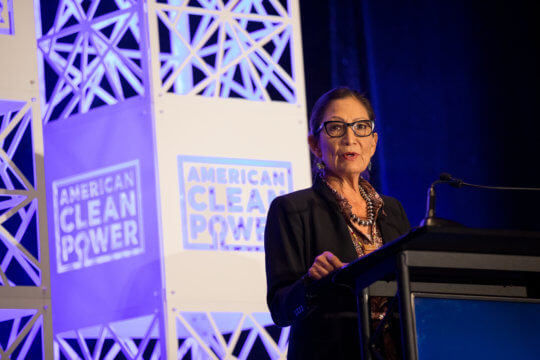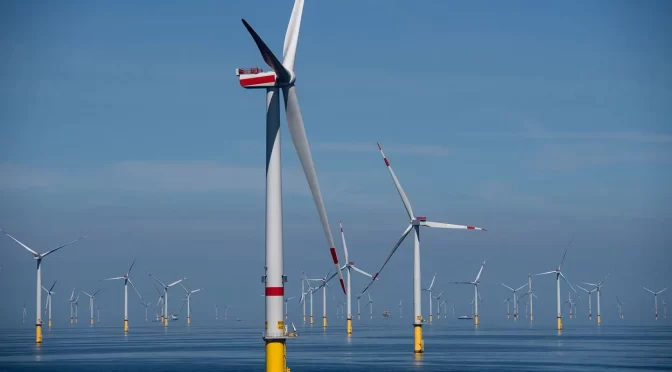Offshore wind is set to become America’s newest domestic source of clean energy and a key part of our nation’s clean power future, and as ACP’s latest report demonstrates, that also means American jobs, economic growth, and billions in federal revenue. This year, the Biden administration set an ambitious but achievable goal of reaching 30 gigawatts of offshore wind by 2030. Recent federal government action, including the final record of decisions for the nation’s 1st and 2nd offshore wind projects in federal waters, set the country up to achieve our offshore wind goal. Momentum is building.
On October 13, at ACP’s Offshore WINDPOWER conference in Boston, Secretary of the Interior Deb Haaland announced plans by the Biden administration to expand offshore wind development across almost all U.S. coastlines. She called the administration’s plan a road map to show “exactly where we’re headed and how to achieve a clean-energy future by 2030.”

U.S. Department of the Interior Secretary Deb Haaland’s announced the Biden administration’s offshore wind framework at Offshore WINDPOWER 2021
The Interior Department envisions as many as seven offshore wind lease sales by 2025, in waters along the Carolinas, California, Oregon, and New York as well as the Central Atlantic and the Gulfs of Mexico and Maine. To date, eight states have established nearly 40 gigawatts of offshore wind procurement targets through legislation, conditional regulatory mandates, or executive orders. The Bureau of Ocean Energy Management’s Offshore Wind Leasing Path Forward 2021-2025 report is a critical step to ensure a smooth transition to the next round of offshore wind projects necessary to meeting both state target and the Biden administration’s 30 GW by 2030 goal.
ACP’s recent report, Federal Revenue and Economic Impacts from BOEM Offshore Wind Leasing examines what new lease sales in seven regions of the country could look like in terms of federal auction, rent, and operating fee revenues, as well as the economic impacts of subsequent offshore wind farm construction in new lease areas. The report was released jointly with ACP-California, the National Ocean Industries Association, the New York Offshore Wind Alliance, RENEW Northeast, Inc., The Southeastern Wind Coalition, and The Special Initiative on Offshore Wind on December 8th.
Estimating the impact in the New York Bight, Northern and Central California, and Carolina Long Bay is relatively straightforward as these areas are already designated and their size is known. The biggest remaining uncertainty is how much developers will be willing to pay to lease the waters, although we will start to get some answers when the Biden Administration conducts its first lease sale in the New York Bight during the first quarter of 2022.
In the remaining four regions, the size of the lease areas that will be put up for auction is not yet known. As such, ACP estimated impacts for both low and high lease area scenarios. The results show that more BOEM leasing drives greater economic impacts and higher federal revenues.
Leasing new offshore wind areas would bring significant economic benefits to communities across the nation.
Using conservative estimates of future auction prices based on historical data, ACP found that lease sales in these seven regions would generate between $1.6 and $2.7 billion over the next four years from winning bids alone. The upcoming New York Bight lease sale will reveal whether increased competition for lease areas driven by growing demand for offshore wind will drive auction prices even higher. Once leases are auctioned, these same leases could generate an additional $1.1 to $1.8 billion in rents and operating fees for a total of $2.7 to $4.5 billion in new federal revenue over the coming decades.
New lease area auctions, depending on their size, could support between 23 GW and 40 GW of new offshore wind projects, representing over $120 billion of clean energy investment. These projects would provide significant economic benefits in the regions that host them. The construction of these projects are expected to support between 73,000 and 128,000 jobs, and a further 28,000 to 48,000 jobs in operations and maintenance roles, in the supply chain, and in surrounding communities for the life of the projects.
BOEM Director Amanda Lefton and Interior Secretary Deb Haaland should be applauded for creating an Offshore Wind Energy Leasing Path Forward for 2021 – 2025. The program will enable job creation, bring in new federal revenue, and create certainty for an industry that is ready to make significant investments in our clean energy future and help combat the global climate crisis.
The full report can be downloaded here.
Author:
Josh KaplowitzVP, Offshore Windjkaplowitz@cleanpower.org


